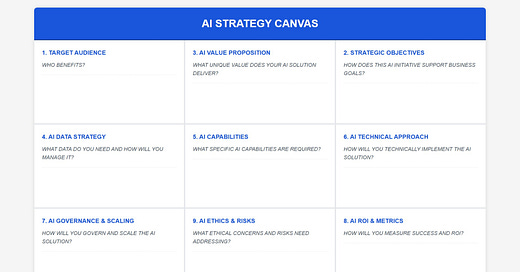In today's rapidly evolving business landscape, artificial intelligence has moved from a futuristic concept to a present-day competitive necessity. Yet, despite significant investments, many organizations struggle to translate AI initiatives into tangible business outcomes. The disconnect between technical implementation and strategic alignment remains one of the primary reasons why AI projects fail to deliver their promised value. Could you remind me how this is NOT different from any other product software development?
The Strategic Alignment Problem
According to MIT Sloan Management Review, nearly 70% of companies report minimal or no impact from their AI initiatives. The root cause isn't typically technological limitations but rather a fundamental misalignment between AI capabilities and business objectives. This misalignment manifests in several ways:
AI projects initiated based on technological fascination rather than business needs
Lack of clear success metrics tied to organizational goals
Insufficient consideration of data requirements and governance
Inadequate planning for scaling beyond proof-of-concept
Ethical and risk considerations are addressed too late in the development process.
Introducing the AI Strategy Canvas
To address these challenges, we've developed the AI Strategy Canvas—a comprehensive framework designed to align AI initiatives with business strategy from inception. This structured approach ensures that AI projects are conceived, developed, and deployed with clear business outcomes in mind.
In our approach, we use many Canvas, and this canvas is also inspired by existing great canvases such as the Business Model Canvas and the Lean Canvas.
The canvas consists of nine interconnected elements that collectively form a holistic view of an AI initiative:
Target Audience: Identifying who will benefit from the AI solution
Strategic Objectives: Clarifying how the AI initiative supports business goals
AI Value Proposition: Defining the unique value the AI solution delivers
AI Data Strategy: Planning what data is needed and how it will be managed
AI Capabilities: Specifying what AI capabilities are required
AI Technical Approach: Determining how to implement the solution technically
AI Governance & Scaling: Establishing how to govern and scale the AI solution
AI ROI & Metrics: Measuring success and return on investment
AI Ethics & Risks: Addressing ethical concerns and potential risks
How the Canvas Transforms AI Strategy
The AI Strategy Canvas serves as a powerful tool for organizations in several ways:
1. Creating a Common Language
One of the most significant barriers to successful AI implementation is the communication gap between technical teams and business stakeholders. The canvas provides a shared vocabulary and visual framework both groups can understand and contribute to, facilitating more productive conversations about AI initiatives.
2. Ensuring Strategic Alignment
The canvas ensures that AI initiatives are anchored in business goals rather than technological possibilities by starting with strategic objectives and target audiences before diving into technical capabilities. This alignment is critical for securing executive buy-in and maintaining focus throughout development.
3. Identifying Dependencies Early
The canvas helps organizations identify critical dependencies—particularly around data availability, quality, and governance—before making significant investments. This early identification prevents the common scenario where AI projects stall midway due to unforeseen data limitations.
4. Balancing Innovation with Practicality
While encouraging innovative applications of AI, the canvas also grounds these innovations in practical considerations like technical feasibility, resource requirements, and governance constraints. This balance helps organizations avoid the twin pitfalls of excessive caution and unbridled optimism.
5. Integrating Ethical Considerations from the Start
Rather than treating ethics as an afterthought, the canvas incorporates ethical considerations and risk management as fundamental components of AI strategy. This proactive approach helps organizations build responsible AI systems that align with their values and regulatory requirements.
Getting Started with the AI Strategy Canvas
Implementing the AI Strategy Canvas in your organization requires thoughtful preparation and execution:
Preparation
Begin by assembling a cross-functional team that includes business leaders who understand organizational objectives, AI/ML experts who can assess technical feasibility, data scientists who can evaluate data requirements, and end-users who will interact with the AI solution.
Allocate 2-3 hours for an initial canvas completion workshop, and gather relevant business strategy documents, data inventories, and AI feasibility assessments beforehand to inform the discussion.
Completion Process
While the canvas can be completed in various sequences, we recommend starting with Strategic Objectives to anchor the AI initiative in business goals. From there, the target audience will be defined, and the AI value proposition will be developed to connect audience needs with objectives.
Next, the AI capabilities required to deliver the value proposition will be outlined, and the AI data strategy and technical approach needed to support these capabilities will be identified.
Finally, evaluate ROI & Metrics to ensure business viability, establish Governance & Scaling for organizational alignment, and address Ethics & Risks to ensure responsible AI development.
Refinement and Implementation
After completing the initial canvas, review it for internal consistency and completeness, identify and resolve contradictions or gaps, prioritize elements based on strategic importance and feasibility, and create action items with clear ownership and timelines.
Use the canvas as a reference document throughout AI development, revisiting and updating it as new capabilities or limitations become apparent. Share it with new team members for onboarding and alignment, and review it quarterly to ensure continued strategic alignment of AI initiatives.
Conclusion: From Technology-Driven to Strategy-Led AI
The AI Strategy Canvas represents a fundamental shift in how organizations approach artificial intelligence—from technology-driven experimentation to strategy-led implementation. The canvas helps organizations develop AI initiatives that deliver measurable value and sustainable competitive advantage by providing a structured framework that bridges technical and business considerations.
In a landscape where AI investments continue to grow but returns remain elusive for many, this strategic approach offers a path forward. By aligning AI capabilities with business objectives from the outset, organizations can transform AI from a promising technology into a powerful driver of business value.




